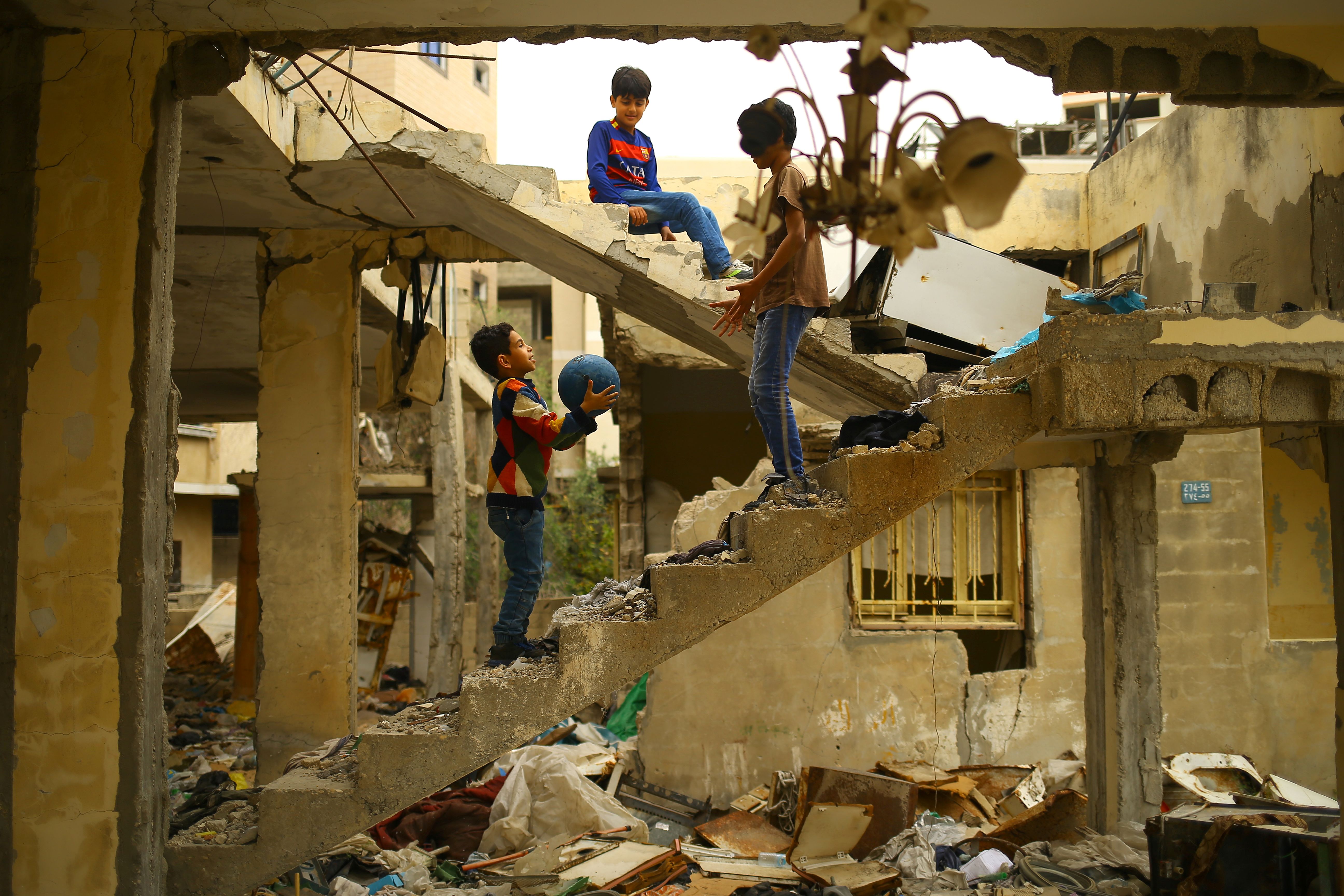
The region has already experienced twenty-two conflicts in the early years of the 21st century, and its future promises far more.
For over a century, world leaders have issued calls for peace in the Middle East , but usually without success. The region has already experienced twenty-two conflicts in the early years of the 21st century, and its future promises far more. This is because of five enduring, persistent tensions that foster conflict in the region, each consisting of a major social, economic, or political change that is colliding with a significant, relatively constant feature of the region. Moreover, all five interact with each other, making the situation that much more complex. Together, they threaten to tear apart the Middle East and spark a global war. Until leaders appreciate and address these tensions, no calls for peace will bring meaningful results.
1. Demographic Growth vs. Geographic and Economic Limitations
The Middle East is geographically stressed and decreasingly capable of sustaining its ballooning population. The 20th century saw the Middle East grow more rapidly than any other region of the world, with an approximate population of 60 million in 1900 topping 410 million by 2018. This puts substantial life cycle pressure on governments to provide social services from schooling to jobs to pensions and medical care later in life. Rapid population growth and frequent insecurity in the region have also caused much population mobility, including very high rates of urbanization and migration (both refugees and labor migrants).
This population increase has occurred in the most arid inhabited region on the planet, which has average rainfall of less than 4 inches per year. Water availability in the region averages 1200 m³ per person per year, just 17% of the fresh water available to most people living elsewhere in the world, and food security has also been affected, especially in areas hit by conflict.
This tension is made more acute by the uneven regional distribution of wealth, which centers broadly on the unequal distribution of hydrocarbon wealth, with six Middle Eastern countries among the world’s top 10 in proven oil reserves. Hydrocarbon-rich Middle Eastern countries have developed wealthy rentier economies relying on external income from other nations with less need for domestic industry. This undercuts social contracts undergird democracy and constrains opportunity for the growing population. For example, youth unemployment rates among Middle East nations average 25% or higher. Countries without hydrocarbon wealth have developed public sector economies whereby they subsidized companies, jobs, and food prices, but this too does not provide much in the way of goods and services for the global market.
2. Young Countries vs. Ancient Societies
The heart of the Middle East is often called the “cradle of civilization,” with ancient cultures in Mesopotamia and the Nile River Valley, and multiple Levantine cities that claim to be the oldest inhabited urban areas in history, such as Aleppo, Byblos, and Damascus. Yet, it is also one of the least politically mature regions in the world after a century of foreign powers dividing Middle East lands while also trying to keep competing promises to Arabs and Jews with regard to Palestine. After World War I, the creation of states out of the detritus of the Ottoman Empire and the short-lived mandates and colonies overlaid alien systems of political identity on top of more traditional bases for identity. This continued after World War II ended colonialism in the region. The subsequent delay in political institutionalization and development of democracy has caused identity crises throughout the region. Filling the void for many Middle Easterners are previously existing forms of identity based on family networks, ethnolinguistic relationships, and sectarian or religious ties, which have often proved stronger than their commitment to their nations.
3. Modern Radical Islamism vs. Traditional Abrahamic Religions
As I stood in the Old City of Jerusalem in October 2017 amid some of the most important holy sites to three religions—all within a short walk from each other—I was reminded that this was the birthplace of Abrahamic monotheism. Judaism, Christianity, and Islam all trace their origins to Abraham or his spiritual tradition, and their adherents of Christianity and Islam today respectively constitute about a third and a quarter of the world’s population. There is substantial convergence among the three faiths—belief in one god, shared prophets, belief in a day of judgment and an afterlife, and a shared conception of morality. These factors have allowed peoples of the three faiths to co-exist in the same geographic spaces for long periods of history. Of course, co-existence has not always been peaceful–from the Crusades, Inquisition, and Holocaust to the more recent cases of ethnic cleansing in the Balkans. The presence in Jerusalem of such venerated locations as the Dome of the Rock and the Temple Mount sharing the same contested space is a reminder of how fragile peace can be among these peoples. Thankfully, from the overall perspective of history, co-existence remains the dominant theme.
Enter the current Islamist movement. Islamism broadly refers to applying Islamic law to social and political life, and Islamic history has had many Islamist movements that advocated or attempted purification of the Islamic societies of their eras. Today’s radical Islamist movement, however, applies strictly conservative interpretations of Islamic law as its foundation, and advocates violent methods to achieve a purer society and/or challenge Christian and Jewish states. Modern Islamism derives from the structural features of Islamic legal orientation combined with the rising educational standards of Middle Eastern states whereby technically educated university graduates began to challenge the ulema (Islamic religious scholars) for the right to determine what an Islamic society should look like. Radical Islamists aim to restore the Caliphate and the mythological “Golden Age” of early Islam through violent extremism. Some Islamist groups, such as Hamas, Hezbollah, Al Qa’ida, and the Islamic State in Iraq and the Levant (ISIS), took up weapons and fought what they considered apostate regimes (the “Near Enemy”) and their supporters, mainly Christian or Jewish states and societies (the “Far Enemy”). Radical Islamist groups have also destroyed historic relics and monuments in the name of purifying Islamic territory. Their vision of a new Caliphate may be unachievable, but that will not stop the radical Islamists, who will continue to strike against their Abrahamic brethren worldwide.
The five tensions of the Middle East are not going away, and will continue to increase instability in the region.
4. The “Arab Spring” vs. Traditional Authoritarianism
Almost every Middle Eastern government embraced autocracy in the 20th century and remained autocratic into the 21st century. These governments were corrupt and disconnected, led by elites who consistently failed to deliver economic well-being, political choice, and civil liberties and rights. Then, in December 2010, protests, demonstrations, violence, and revolution, swept the Arab World. Governments fell in Tunisia, Egypt, Yemen, and Libya, while reforms took place almost everywhere else. This regional upheaval came to be called the “Arab Spring,” which promised to finally bring democracy to this wholly undemocratic region.
Unfortunately, the promise has been unfulfilled. Six years later, the Economist Intelligence Unit’s Democracy Index in 2016 held that the 20 Middle Eastern countries (plus Palestine) had the lowest regional score for democracy of any region. Sustained by a tradition of hereditary rule, Middle Eastern governments have long been patrimonial and dynastic, with power closely held by rulers and passed along to physical or at least political descendants. There are still few meaningful legislatures, independent judiciaries, or free and fair elections. Civil society and the media are constrained by repressive regulations and thus underdeveloped. At present, those in power have the upper hand, but it is unclear whether they can continue to hold back the aspirations of their increasingly restive youth in an age of globalization.
5. Great Power Competition vs. Inattention
The Cold War was an era of rivalry between the Soviet Union and United States, but the focus of their competition was in Europe and the Pacific Rim. Both great powers had interests in the Middle East, but mostly kept their militaries out of the region. The United States, for example, invested in oil and sold military hardware, but kept its military postured for conflict elsewhere. When the powers did intervene in the Middle East—such as Soviet involvement in Egypt under Nasser and the U.S.-led Persian Gulf War—the long-term results were not favorable. Unfortunately, the same can be said for fifteen years of U.S. military involvement in the region since the invasion of Iraq. Some of the fallout includes persecution of religious minorities and the rise of the Islamic State in Iraq and the Levant (ISIS).
More importantly, America’s position has changed in the world, allowing a resurgent Russia, rising China, and awakening India to challenge each other and American hegemony. The Middle East has become an important arena of their competition, especially because of oil. Half of China’s oil comes out of the Persian Gulf to fuel the economic rise of what is now the world’s largest oil importer. India, the world’s third-leading oil importer, gets more than half of its oil from the region, and India is also the world’s leading recipient of labor remittances from overseas workers, primarily from laborers employed in the Persian Gulf. The second-leading oil exporter in the world, Russia is interested in Middle Eastern oil primarily for what its availability and pricing do to the market for Russian oil. Other Russian interests in the Middle East include arms sales, base access (its only bases outside of the traditional Soviet zone are in Syria), and the creation and expansion of an anti-access/area-denial zone in the Black Sea region. Meanwhile, this is happening as the global position of the United States has slipped during an Obama Administration that struggled to “lead from behind” and a Trump Administration marked by erratic swings from foreign policy adventurism to “America First” neo-isolationism.
Powerful nations with competing interests often find that the collision of those interests leads to war. Having so many great power interests converge in a part of the world that has historically been an active arena of conflict is worrisome. Since the late 1970s, the region has had the highest number of fatalities due to war. Three of the world’s top five countries in military spending per capita are Middle Eastern (Saudi Arabia is first, Israel is third, and Kuwait is fifth). Middle Eastern countries have also developed or pursued weapons of mass destruction, with Israel widely known to have nuclear weapons and a robust delivery capability, while seven Middle Eastern countries have or have had biological or chemical weapons. Syria, Afghanistan, and Iraq currently occupy the bottom three spots on the Global Peace Index. As great power competition resurfaces and now takes place in a conflict-prone, unstable Middle East, the question seems not to be if great power conflict will occur, but when.
Implications
The Syrian Civil War is taking place across young countries and among groups anchored by affiliation to preexisting identity classifications. In such a war the violence will activate traditional codes of honor. An identity war between sectarian, ethnolinguistic, and/or family groups in the Middle East will protract and widen. The major outside powers, the United States and Russia, have already become directly involved and developed regional alliances with countries that share their preferences in the war’s outcome. Conflict has expanded to theaters in Yemen, Libya, the Sinai, and even farther afield where ISIS affiliates have struck.
The challenge facing U.S. leaders is how to contain this spreading conflict so that impacts on the global economy are contained, large refugee populations do not relocate outside of the region, and the violence of extremist groups does not spread. But combining the sectarian character of the current violence with its identity group overtones, attempts to contain violence to the region make it more likely to worsen. Therefore, finding ways to tamp down the violence is also necessary. U.S. leaders must either reclaim global leadership, which is difficult under present fiscal constraints, or seek a cooperative solution with other powers, which may involve granting unpalatable concessions, or work independently in the background to alleviate all the above tensions. Only the second option appears feasible and does not guarantee peaceful outcomes.
The five tensions of the Middle East are not going away, and will continue to increase instability in the region. They also leave the region open to the disruptive interventions of great powers, an arena for a modern Great Game as China and Russia, seeking to revise the international order, compete with the United States for power and influence. Given their competing interests, outside powers probably will not stop meddling, funding proxies and exacerbating rivalries.
On my next visit to Israel perhaps I will visit Tel Megiddo once again for a glimpse at the region’s future—only, I won’t stay long.
Larry Goodson is Professor of Middle East Studies at the U.S. Army War College. The views expressed in thisarticle are those of the author and do not necessarily reflect those of the U.S. Army War College, U.S. Army, or the Department of Defense.
Photo: Palestinian children play amidst the ruins of a building destroyed during the 50-day war between Israel and Hamas militants during the summer of 2014 in Gaza City, on April 13, 2017.
Photo Credit: MOHAMMED ABED/AFP/Getty Images





Well written. As the US begins to fully realize the use of its abundant natural gas it will continue to loose interest in this area and the interest of China and Russia will rise.
Bob,
Interesting analysis of the underlying factors for the regions political instabilities. An argument could be constructed that the continuation of emphasis of establishing command based economies will only protract the instability in the region.
Establishing the provisions and protection of a market economy provides for the decisions on goods and services result from interactions of citizens and businesses, with minimal government control. As long as solutions that are based on the provision of goods and services being provided by the government, dissatisfaction will remain rampant. Governments, in the form of command economies, can not satisfy the needs and wants of a society. History has demonstrated this assertion. The region has been held back from implementing free market economics due to the remnants of colonialism.
The argument continues that regardless if a local government or an organization such as the United Nations attempts to “solve” the disproportionate distribution of economic assets the results will continue.
It may be time to introduce market economies into the region and withdraw government programs that distort economic development.
Please read my book auschwitz on the Potomac and the birth of the Israeli nation in it you will find a peace plan between Israelis and Palestinians